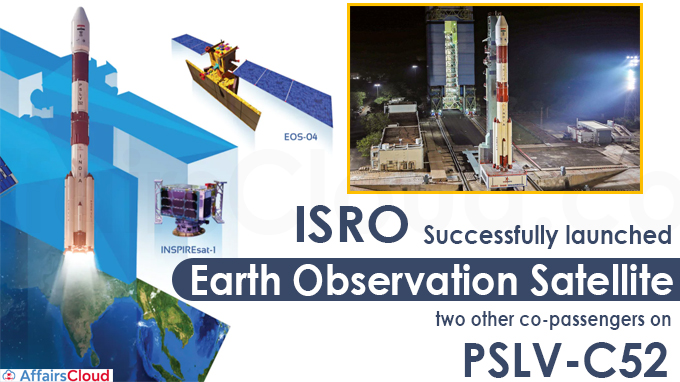 On 14th February 2022 Indian Space Research Organisation’s (ISROs) Polar Satellite Launch Vehicle (PSLV-C52) successfully injected Earth Observation Satellite (EOS-04), with 2 rideshare satellites viz, INSPIREsat-1 & INS-2TD into sun-synchronous polar orbit of 529 km altitude from Satish Dhawan Space Centre (SDSC), Sriharikota Range (SHAR), Andhra Pradesh (AP).
On 14th February 2022 Indian Space Research Organisation’s (ISROs) Polar Satellite Launch Vehicle (PSLV-C52) successfully injected Earth Observation Satellite (EOS-04), with 2 rideshare satellites viz, INSPIREsat-1 & INS-2TD into sun-synchronous polar orbit of 529 km altitude from Satish Dhawan Space Centre (SDSC), Sriharikota Range (SHAR), Andhra Pradesh (AP).
- This was the 80th launch vehicle mission from SDSC SHAR, Sriharikota, 54th flight of PSLV and the 23rd flight of PSLV in XL configuration (6 strap-on motors).
Launch Highlights:
i.The satellite weighs about 1,710 kg, generating 2,280 Watt power with a mission life of 10 years.
ii.The satellite EOS-04 that was realised at UR Rao Satellite Centre, Bengaluru, is also known as a Radar Imaging Satellite (RISAT) designed to provide high-quality images under all weather conditions.
iii.The spacecraft will collect observation data in C-Band completing the observations done by Resourcesat, Cartosat, and RISAT-2B series.
- This is mainly used for applications such as agriculture, forestry & plantations, soil moisture & hydrology and flood mapping.
Note – ISRO plans to conduct the PSLV-C53 mission in March 2022, which will carry OCEANSAT-3 and INS 2B ANAND into orbit.
About Co-passenger satellites:
i.Co-passenger satellites were successfully separated from the PSLV in a predetermined sequence. The two other satellites are,
- A student satellite (INSPIREsat-1) from the Indian Institute of Space Science & Technology (IIST) in association with the Laboratory of Atmospheric & Space Physics at the University of Colorado, Boulder.
- ISRO’s Boulder and a technology demonstrator satellite (INS-2TD), which is a precursor to India-Bhutan Joint Satellite (INS-2B).
INSPIREsat-1:
The student satellite is around 8.1-kilogram with 1-year mission life focusses at improved understanding towards ionosphere dynamics (the layer of the earth’s atmosphere between about 80 & 1,000 kilometres above the surface of the Earth) and the sun’s coronal heating process.
INS-2TD:
The satellite weighs around 17.5 kilograms with 6 months operational lifetime and it carries a thermal imaging camera that will aid in the assessment of land, water surface temperatures, delineation of vegetation and thermal inertia.
About Indian Space Research Organisation (ISRO):
Chairman – S Somanath
Headquarters – Bengaluru, Karnataka




